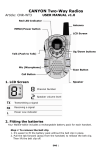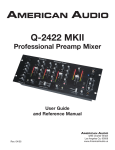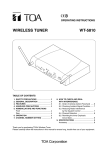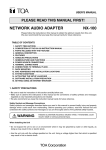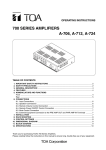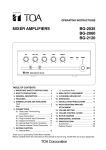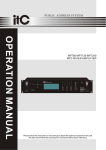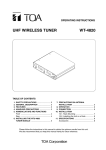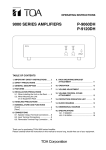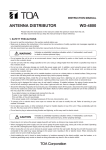Download Manual
Transcript
OPERATING INSTRUCTIONS WIRELESS TUNERS AF WT-5800 WT-5805 PE AK BT T A AN T B DIV ER SIT UH YW FW IRE IRE LE LE SS SS TU NE R WT -58 00 VO L UP 10 SE T DO W PO WE R TABLE OF CONTENTS 1. 2. 3. 4. 5. SAFETY PRECAUTIONS .......................... GENERAL DESCRIPTION ........................ FEATURES ................................................ HANDLING PRECAUTIONS ..................... NOMENCLATURE AND FUNCTIONS Front ........................................................... Rear ............................................................ 6. OPERATION 6.1. Basic Operation ................................... 6.2. Function Settings ................................. 2 3 3 4 4 5 7. HOW TO CHECK AND DEAL WITH INTERFERENCE .............................. 9 8. CONNECTION EXAMPLES ..................... 10 9. RACK MOUNTING ................................... 11 10. SPECIFICATIONS .................................... 12 Accessories ............................................... 12 Optional products ...................................... 12 5 6 Thank you for purchasing TOA's Wireless Tuner. Please carefully follow the instructions in this manual to ensure long, trouble-free use of your equipment. 1. SAFETY PRECAUTIONS • Be sure to read the instructions in this section carefully before use. • Make sure to observe the instructions in this manual as the conventions of safety symbols and messages regarded as very important precautions are included. • We also recommend you keep this instruction manual handy for future reference. Safety Symbol and Message Conventions Safety symbols and messages described below are used in this manual to prevent bodily injury and property damage which could result from mishandling. Before operating your product, read this manual first and understand the safety symbols and messages so you are thoroughly aware of the potential safety hazards. WARNING Indicates a potentially hazardous situation which, if mishandled, could result in death or serious personal injury. When Installing the Unit • Do not expose the unit to rain or an environment where it may be splashed by water or other liquids, as doing so may result in fire or electric shock. • Use the unit only with the voltage specified on the unit. Using a voltage higher than that which is specified may result in fire or electric shock. • Do not cut, kink, otherwise damage nor modify the power supply cord. In addition, avoid using the power cord in close proximity to heaters, and never place heavy objects -- including the unit itself -- on the power cord, as doing so may result in fire or electric shock. • Avoid installing or mounting the unit in unstable locations, such as on a rickety table or a slanted surface. Doing so may result in the unit falling down and causing personal injury and/or property damage. • To prevent lightning strikes, install the unit at least five meters away from a lightning rod, and yet within the protective range (angle of 45°) of the lightning conductor. Lightning strikes may cause a fire, electric shock or personal injury. • Since the unit is designed for in-door use, do not install it outdoors. If installed outdoors, the aging of parts causes the unit to fall off, resulting in personal injury. Also, when it gets wet with rain, there is a danger of electric shock. When the Unit is in Use • Should the following irregularity be found during use, immediately switch off the power, disconnect the power supply plug from the AC outlet and contact your nearest TOA dealer. Make no further attempt to operate the unit in this condition as this may cause fire or electric shock. · · · · · If you detect smoke or a strange smell coming from the unit. If water or any metallic object gets into the unit If the unit falls, or the unit case breaks If the power supply cord is damaged (exposure of the core, disconnection, etc.) If it is malfunctioning (no tone sounds.) • Do not place cups, bowls, or other containers of liquid or metallic objects on top of the unit. If they accidentally spill into the unit, this may cause a fire or electric shock. • Do not touch the unit's antennas during thunder and lightning, as this may result in electric shock. 2 CAUTION Indicates a potentially hazardous situation which, if mishandled, could result in moderate or minor personal injury, and/or property damage. When Installing the Unit • Never plug in nor remove the power supply plug with wet hands, as doing so may cause electric shock. • When unplugging the power supply cord, be sure to grasp the power supply plug; never pull on the cord itself. Operating the unit with a damaged power supply cord may cause a fire or electric shock. • When moving the unit, be sure to remove its power supply cord from the wall outlet. Moving the unit with the power cord connected to the outlet may cause damage to the power cord, resulting in fire or electric shock. When removing the power cord, be sure to hold its plug to pull. • The socket outlet shall be installed near the equipment and shall be easily accessible. • Avoid installing the unit in humid or dusty locations, in locations exposed to the direct sunlight, near the heaters, or in locations generating sooty smoke or steam as doing otherwise may result in fire or electric shock. • Leave the installation of an antenna to your TOA dealer because the installation requires expert knowledge. The falling of an antenna may cause electric shock. When the Unit is in Use • Do not place heavy objects on the unit as this may cause it to fall or break which may result in personal injury and/or property damage. In addition, the object itself may fall off and cause injury and/or damage. • Make sure that the volume control is set to minimum position before power is switched on. Loud noise produced at high volume when power is switched on can impair hearing. • Never open the unit case as there are high temperature parts inside the unit, which may cause a burn if touched. Refer all servicing to your nearest TOA dealer. • Use the dedicated AC-DC adapter for the unit. Note that the use of other adapter may cause a fire. • If dust accumulates on the power supply plug or in the wall AC outlet, a fire may result. Clean it periodically. In addition, insert the plug in the wall outlet securely. • Switch off the power, and unplug the power supply plug from the AC outlet for safety purposes when cleaning or leaving the unit unused for 10 days or more. A fire or electric shock may result. • Any modifications made to this device that are not approved by TOA Corporation may void the authority granted to the user to operate this equipment. • The term "IC:" before the radio certification number only signifies that the Industry Canada technical specifications were met. Operation is subject to the following two conditions: (1) this device may not cause interference, and (2) this device must accept any interference, including interference that may cause undesired operation of the device. 2. GENERAL DESCRIPTION The WT-5800/5805 Wireless Tuner is designed for use on the UHF band, and suitable for vocal or speech reinforcement applications. It features a compander circuit which minimizes the influence of ambient noise. 3. FEATURES • 64 different operating frequencies (4 banks x 16 channels) • An optimized PLL-synthesizer drastically minimizes the oscillation frequency drift resulting from the ambient temperature changes. • The Scan function indicates available idle channels and is useful when changing the operating frequency. • The LCD screen indicates the current operating frequency, as well as RF and AF levels. 3 • Antenna distribution outputs (WT-5800 only) and audio cascade inputs facilitate connection of another unit to build a dual-channel system. • Compact and high reliability 4. HANDLING PRECAUTIONS • Make sure that the power switch is switched OFF after use. • When mounting in an equipment rack, select the position which does not expose the unit to high temperature. • When installing, keep the unit as far away as possible from fluorescent lamps, digital equipment, personal computers, and other equipment which generate high frequency noise. • Only the same bank wireless systems can be used in the same location. Avoid using the systems in combination with those of different banks because interference or noise could be generated. • Wireless tuners to be installed in the same location must differ from each other in channel number. Setting them for the same channel number could result in noise. Wireless microphones must be identical to wireless tuners in both bank and channel numbers. • When using two or more wireless microphones, keep them at least 50 cm away from each other to avoid malfunctions or noise. • Keep the wireless microphone at least 3 m away from the receiving antenna. Using the microphone in close proximity to the antenna could result in malfunctions or noise. • Be sure to connect at least two receiving antennas (one each for Channels A and B). 5. NOMENCLATURE AND FUNCTIONS [Front] This figure represents WT-5800. UP POWER SET AF PEAK BTT ANT A B DOWN UHF WIRELESS DIVERSITY WIRELESS TUNER WT-5800 2 3 4 5 1. Power switch Press this switch to turn the power on, and press it again to turn off the power. 2. AF peak lamp Lights when the output level reaches the point of about 3 dB below the clipping level. 3. Battery alarm lamp Lights when the battery voltage in the corresponding wireless microphone becomes low. 4. Reception lamps Either lamp of A (left) or B (right) lights yellow when the tuner receives a radio signal. 4 VOLUME 0 10 6 7 8 1 5. LCD screen Displays the receiving frequency, and RF/AF levels in 6 steps when the unit is in normal operating state. In setting mode, the screen displays the setting items and their contents. 6. Volume control Adjusts an output level. 7. Up/Down keys Select the setting items displayed on the screen. 8. Set key Brings the unit in setting mode when pressed in normal operating state. In setting mode, pressing the Set key determines the selected setting item and registers its contents. [Rear] This figure represents WT-5800. ANT B DC IN I/O OUTPUT 600 BALANCED MIX IN 10k UNBALANCED ANT A UNBALANCED -20dBV LEVEL IN OUT OUT 12 18V 9 10 270mA max LINE -20dBV 1 MIC -60dBV 11 12 13 14 9. Antenna input A, B For signal routing A. Input: 75 Ω, BNC For the wireless system covering a relatively narrow area, use the supplied two rod antennas, which should be set up at a 45° angle outwards from a vertical line. 10. Antenna distribution output A, B (WT-5800 only) 75 Ω, BNC 11. Cable hanger Hook the power cable onto this part. 2 IN HOT COLD 3 17 15 16 10 9 13. I/O port Used for service only. 14. AF output –20 dB*/– 60 dB* selectable, unbalanced, phone jack. 15. AF output level selector Sets the output level from the AF outputs by selecting either MIC (– 60 dB*/600 Ω) or LINE (–20 dB*/600 Ω). 16. AF output –20 dB*/ – 60 dB* selectable, balanced, XLR connector, male type (pin #2: Hot) Power cable Cable hanger 17. AF mixing input –20 dB*, 10 kΩ, unbalanced, phone jack. Connects to other unit's AF output. 12. DC input jack Connect the power cable of the supplied AC-DC adapter to this jack. * 0 dB = 1 V 6. OPERATION 6.1. Basic Operation UP POWER SET AF PEAK BTT ANT A B DOWN UHF WIRELESS DIVERSITY WIRELESS TUNER WT-5800 Reception lamps VOLUME 0 10 3 1 Step 1. Turn the power on, and the LCD screen comes to display the receiving frequency and RF/AF levels. Step 2. Set the microphone switch to the ON position. The reception lamp lights when the tuner receives the same frequency signal. Step 3. Adjust the volume control. The output level increases as the control is rotated clockwise, and decreases as rotated counterclockwise. 5 6.2. Function Settings [Keys used in setting mode] LCD screeen Up key UP POWER SET AF PEAK BTT ANT A B DOWN UHF WIRELESS DIVERSITY WIRELESS TUNER WT-5800 VOLUME 0 10 Set key Down key Setting items displayed on the LCD screen The display cycles through the indications "SET CHANNEL," "SET BANK," "SET SQ LEVEL," "SET LCD POWER," CHANNEL CHECK," "RF CHECK," "About Model" and "Exit" with each depression of the Up key, or the Down key for the reverse action. 6.2.1. Channel (frequency) setting Step 1. Press the Set key for about a second until the screen displays the first setting item "SET CHANNEL." The unit is placed in setting mode. Step 2. Press the Set key, and the screen displays the currently-set channel and frequency with the prefix ">=" indication. (Example: >=8: 684.000 MHz) Step 3. Select the desired channel/frequency with the Up or Down key. The display cycles through the contents with each depression of the Up or Down key. Step 4. Press the Set key to register the selected channel/frequency. This terminates the Channel (frequency) setting, and the display returns to the "SET CHANNEL" indication. Note When leaving the original channel/frequency unchanged, select "Exit" with Up or Down key and press the Set key. Then, the display returns to the "SET CHANNEL" indication. Step 5. When any other setting is not needed, select "Exit" with the Up or Down key and press the Set key. The unit returns to the normal operating state. 6.2.2. Bank number/frequency setting Step 1. Press the Set key for over a second to place the unit in setting mode. Step 2. Select the setting item "SET BANK" with the Up or Down key. Step 3. Press the Set key again, and the screen displays the currently-set Bank number and frequency with the prefix ">=" indication. (Example: >=1:7 684.000 MHz) Step 4. Select the desired Bank number/frequency with the Up or Down key. The display cycles through the contents with each depression of the Up or Down key. Step 5. Press the Set key to register the selected Bank number/frequency. This terminates the Bank number/frequency setting, and the display returns to the "SET BANK" indication. Note When leaving the original Bank number/frequency unchanged, select "Exit" with Up or Down key and press the Set key. Then, the display returns to the "SET BANK" indication. Step 6. When any other setting is not needed, select "Exit" with the Up or Down key and press the Set key. The unit returns to the normal operating state. 6 6.2.3. Squelch level setting The WT-5800/5805 tuner has the squelch function that virtually eliminates ambient noise and unwanted audio signals from other wireless microphone systems by silencing the output when the signal received is lower than a certain level of signal strength. This strength level can be varied by means of the squelch control. Step 1. Press the Set key for over a second to place the unit in setting mode. Step 2. Select the setting item "SET SQ LEVEL" with the Up or Down key. Step 3. Press the Set key, and the squelch level adjustment display "RF >" appears on the screen. Step 4. Set the squelch level referring to the on-screen bar-graph meter (6 segments) which can be changed with Up or Down key. Step 5. Press the Set key to register the selected value. This terminates the Squelch level setting, and the display returns to the "SET SQ LEVEL" indication. Note When leaving the original value unchanged, select "Exit" with Up or Down key and press the Set key. Then, the display returns to the "SET SQ LEVEL" indication. Step 6. When any other setting is not needed, select "Exit" with the Up or Down key and press the Set key. The unit returns to the normal operating state. The squelch level ranges from "0" to "6." The wireless tuner's sensitivity is the highest and radio signals can be received in wide areas when the "0" level is selected, while the "6" level makes the sensitivity the lowest, limiting signal reception only to narrow areas. The wireless microphone's signal transmission distance varies largely depending on its ambient conditions. The table below provides guidelines on the squelch level vs. transmission distance. Squelch Level Transmission Distance (%) 0 100 1 85 2 70 3 50 4 30 5 20 6 15 Note: Transmission distance is a relative ration with respect to 100% at "0" level. Tips • Set the control to the "0" position in locations free from interference. • Set the control to the position that does not cause any reception loss of wireless microphone signals. 6.2.4. LCD backlight brightness adjustment Step 1. Press the Set key for over a second to place the unit in setting mode. Step 2. Select the setting item "SET LCD POWER" with the Up or Down key. Step 3. Press the Set key, and the brightness adjustment display appears on the screen. Step 4. Select either "HIGH (Bright)" or "LOW (Dark)" with the Up or Down key. Step 5. Press the Set key to register the selected brightness level. This terminates the Brightness setting, and the display returns to the "SET LCD POWER" indication. Step 6. When any other setting is not needed, select "Exit" with the Up or Down key and press the Set key. The unit returns to the normal operating state. 7 6.2.5. Channel detection Step 1. Press the Set key for over a second to place the unit in setting mode. Step 2. Select the setting item "CHANNEL CHECK" with the Up or Down key. Step 3. Press the Set key. Channel detection begins, and an idle channel number with frequency is displayed on the screen. When 2 or more idle channels exist, each of them can be displayed in sequence with the Up or Down key. If no idle channel is detected, "Vacant CHANNEL doesn't exist" is displayed. Step 4. Press the Set key to register the selected channel. This terminates the Channel detection, and the display returns to the "CHANNEL CHECK" indication. Note When leaving the original channel unchanged, select "Exit" with Up or Down key and press the Set key. Then, the display returns to the "CHANNEL CHECK" indication. Step 5. When any other setting is not needed, select "Exit" with the Up or Down key and press the Set key. The unit returns to the normal operating state. 6.2.6. RF check Step 1. Adjust the volume control to decrease the volume. (Big noise is output if the unit is placed in RF check mode when no signal is present.) Step 2. Press the Set key for over a second to place the unit in setting mode. Step 3. Select the setting item "RF CHECK" with the Up or Down key. Step 4. Press the Set key to check idle channels by hearing sound. The receiving antenna alternates between Antenna A and Antenna B with each depression of the Up or Down key. Step 5. Press the Set key again after check completion. This exits the RF check mode, and the display returns to the "RF CHECK" indication. Step 6. When any other setting is not needed, select "Exit" with the Up or Down key and press the Set key. The unit returns to the normal operating state. 6.2.7. Confirming firmware version Step 1. Press the Set key for over a second to place the unit in setting mode. Step 2. Select the setting item "About Model" with the Up or Down key. Step 3. Press the Set key to display the firmware version. Step 4. Press the Set key again to exit the firmware display mode. The display returns to the "About Model" indication. Step 5. When any other setting is not needed, select "Exit" with the Up or Down key and press the Set key. The unit returns to the normal operating state. 8 7. HOW TO CHECK AND DEAL WITH INTERFERENCE [Order of Actions (Action Flowchart)] Place unit in RF check mode and check signal condition of the channel. Any interference? Refer to p. 8 "6.2.6. RF check." [No] Use as is. [Yes] Change bank/channel numbers to those of idle channels. Refer to p. 6 "6.2.2. Bank number/frequency setting." It is convenient to use "CHANNEL CHECK" when selecting idle bank/channel numbers. Refer to p. 8 "6.2.5. Channel detection." Place unit in RF check mode for a while and check signal condition of the channel. Any interference? [No] Use as is. [Yes] Most interference can be avoided by operations above. If interference is still encountered, select channel having relatively less interference using RF check switch, then continue following operations. Adjust squelch control to limit service area. Any interference? Refer to p. 7 "6.2.3. Squelch level setting." [No] Use as is. [Yes] When radio interference is still encountered, consult shop from where unit was purchased. 9 8. CONNECTION EXAMPLES Be sure to connect at least two receiving antennas (one each for Channels A and B). [Example 1] Wall-mounted wireless antenna YW-4500 (optional) Accessory Wall-mounted wireless antenna YW-4500 (optional) Accessory or or ANT B DC IN I/O OUTPUT 600 BALANCED MIX IN 10k UNBALANCED WT-5800/5805 ANT A UNBALANCED -20dBV LEVEL IN OUT OUT 12 18V LINE -20dBV 270mA max 1 MIC -60dBV 2 3 IN HOT COLD From other tuner's AF output Unbalanced AC-DC adapter To amplifier's MIC or LINE input Balanced To amplifier's MIC or LINE input Unbalanced [Example 2] Wall-mounted wireless antenna YW-4500 (optional) Accessory Wall-mounted wireless antenna YW-4500 (optional) Accessory or or ANT B DC IN I/O OUTPUT 600 BALANCED MIX IN 10k UNBALANCED 1st WT-5800 unit ANT A UNBALANCED -20dBV LEVEL IN OUT OUT 12 18V 270mA max LINE -20dBV 1 MIC -60dBV 2 3 IN HOT COLD AC-DC adapter ANT B DC IN I/O OUTPUT 600 BALANCED MIX IN 10k UNBALANCED 2nd WT-5800/5805 unit ANT A UNBALANCED -20dBV LEVEL IN OUT OUT 12 18V 270mA max LINE -20dBV 1 MIC -60dBV 2 3 AC-DC adapter Balanced IN HOT COLD To amplifier's MIC or LINE input To amplifier's MIC or LINE input Unbalanced 10 9. RACK MOUNTING • When mounting one WT-5800/5805 unit, use an optional mounting kit MB-WT3. Bracket B *1 WT-5800/5805 AF PE AK BT T A AN T B DIVE RS ITY UHF WIR WIR EL EL ES ES S TU S NE RW T-58 00 VO L UP SE 10 Fiber washer (for M5) T DO W *1 PO WER Rack mounting screw *1 5 x 12 Bracket A *1 *1 Component parts of the MB-WT3. • When mounting two WT-5800/5805 units, use an optional mounting kit MB-WT4. Rack mounting screw *2 5 x 12 WT-5800/5805 AF PE AK BT T A AN T B DIVE RS ITY UHF WIR WIR EL EL ES ES S TU S NE RW T-58 00 VO L UP SE 10 T DO W Fiber washer *2 (for M5) PO WER AF PE AK WT-5800/5805 BT T A AN T B DIVE RS ITY UHF WIR WIR EL EL ES ES S TU S NE RW T-58 00 VO L UP SE 10 T DO W Connector PO WER *2 Bracket *2 *2 Component parts of the MB-WT4. 11 10. SPECIFICATIONS Model Number Power Source Power Consumption Receiving Frequency Selectable Channel Receiving System Diversity System AF Output AF Mixing Input Antenna Input Antenna Output Receiving Sensitivity Squelch Sensitivity Squelch System Tone Frequency Indicator Channel Check S/N Ratio Harmonic Distortion Frequency Response Operating Temperature Finish Dimensions Weight WT-5800 WT-5805 120 V AC (Supplied AC-DC adapter must be used.) 250 mA (12 V DC) 200 mA (12 V DC) 636 – 698 MHz, UHF 64 selectable frequencies Double super-heterodyne Space diversity (true diversity) Space diversity MIC/LINE: –60 dB* (MIC)/–20 dB* (LINE) selectable, 600 Ω Phone jack (unbalanced), XLR-3-31 type connector (balanced) –20 dB*, 10 kΩ, unbalanced, phone jack 75Ω, BNC (phantom powering for antenna), 9 V DC, 30 mA (max) 75Ω, BNC (Gain 0 dB) Over 90 dB, S/N ratio (20 dBμV input, 40 kHz deviation) 18 – 40 dBμV variable Using together of noise SQ, carrier SQ and tone SQ 32.768 kHz Audio (6 steps), RF (6 steps), ANT A/B, Audio (peak), Battery alarm Usable frequencies scanning Over 110 dB (A-weight, unbalanced output) Under 1% (typical) 100 – 15000 Hz, ±3 dB –10°C to +50°C Resin, black 210 (w) x 44 (h) x 205.1 (d) mm 700 g * 0 dB = 1 V Note: The design and specifications are subject to change without notice for improvement. • Accessories AC-DC adapter ........................................... 1 • Optional products Mounting bracket kit: MB-WT3 (for rack mounting one WT-5800/5805 unit) MB-WT4 (for rack mounting two WT-5800/5805 units) URL: http://www.toa.jp/ 133-07-268-20












